I stumbled upon this one pan pasta recipe on a busy Tuesday evening. My family wanted something warm and filling. I mixed the rich flavors of classic soup with tender noodles in one skillet.
This dish turns simple ingredients into restaurant-quality meals in just 20 minutes. Caramelized aromatics create a creamy, golden sauce coating every pasta strand. This weeknight experiment became my favorite comfort food fix.
The recipe shines in its simplicity and speed. Everything cooks in one skillet, meaning less cleanup time. You can enjoy dinner with loved ones sooner.
This dish impresses with its flavors without any fuss. It’s perfect for feeding hungry teens or hosting friends.
Key Takeaways
- Ready in just 20 minutes using one pan pasta technique for quick weeknight dinners
- Combines classic soup flavors with creamy pasta for ultimate comfort food experience
- Minimal cleanup required since everything cooks in a single skillet
- Restaurant-quality results achieved with simple, affordable ingredients
- Easily customizable with vegan, dairy-free, and gluten-free variations
- Perfect for busy families seeking satisfying, homemade meals
What is One-Pan French Onion Pasta?
This creative recipe reimagines French onion soup as a comforting pasta meal. It brings together two beloved comfort foods into one satisfying experience. The result is a hearty, flavorful pasta that captures the classic French onion magic.
Overview of the Dish
French onion pasta is a brilliant fusion of traditional soup flavors into a creamy pasta dish. The recipe centers around deeply caramelized onions that create a rich, golden base. These sweet, tender onions coat every pasta strand with incredible flavor.
This french onion recipe is special because of its one-pan approach. Everything cooks together, allowing the pasta to absorb all the amazing onion flavors directly. The cooking liquid becomes a silky sauce that binds everything perfectly.
This recipe keeps things simple, unlike complicated pasta dishes requiring multiple pots and pans. The pasta cooks right in the same pan with the onions and broth. This method creates layers of flavor you can’t achieve with separate cooking.
Key Ingredients
The foundation of any great french onion recipe starts with yellow onions. Large yellow onions caramelize beautifully and develop that signature sweetness. You’ll need about 3-4 large onions for the best flavor impact.
For the pasta, shapes that hold sauce well work best. Penne, rigatoni, or shells trap all that delicious onion goodness perfectly. The choice of pasta can really make or break your final dish.
The liquid base typically includes beef or vegetable broth for depth. Some recipes call for white wine, adding a lovely acidic balance to the sweet onions. Gruyere and Parmesan cheeses provide that authentic French onion soup flavor profile.
Fresh herbs like thyme and bay leaves enhance the overall taste. A touch of garlic and butter rounds out the ingredient list. These simple components create something truly special, like viral pasta recipes combining basic ingredients for maximum impact.
The Inspiration Behind the Recipe
French onion soup has fascinating origins dating back centuries. Some historians trace it to King Louis XV, who created a version with onions, butter, and champagne. Others credit Nicolas Appert, a French chef, with developing the classic recipe we know today.
The soup became popular because onions were affordable and available year-round. French cooks learned to caramelize them slowly, creating incredible depth from simple ingredients. This technique became the heart of the traditional french onion recipe.
Modern cooks embrace this fusion approach for its familiar flavors in a new format. The pasta version satisfies our craving for comfort food while offering something fresh. It proves that classic flavors never go out of style when presented creatively.
Benefits of One-Pan Cooking
One-pan cooking creates amazing dishes with little effort. It’s changed how I make weeknight meals. This one pot meal method is popular for good reason.
All ingredients work together in one pan. This creates something special. It’s less stressful than using multiple pots and pans.
Time-Saving Advantages
One-pan cooking saves prep and cooking time. Everything cooks in one vessel. It’s perfect for busy nights when you want quick comfort food.
The French onion pasta takes just 20 minutes. Dinner’s ready while others are still planning their meal.
The streamlined process means more eating, less cooking. It’s my go-to for fast, tasty dinners.
Less Cleanup Required
One-pan cooking means less cleanup. I use one pan, one spoon, and few prep bowls. It saves time at the sink.
Traditional pasta needs separate pots for pasta and sauce. One-pan cooking skips this step. Fewer dishes mean more time to relax after dinner.
This is great on busy nights. No pile of dirty cookware awaits me.
Flavor Infusion
One-pan cooking creates amazing flavors. Pasta absorbs seasoned liquid as it cooks. This builds depth that other methods can’t match.
Caramelized onions flavor the cooking liquid. The pasta soaks up this rich taste. Every bite delivers the full French onion experience.
This technique creates layers of taste. The result is more flavorful than traditional methods. Pasta becomes part of the flavor, not just a sauce carrier.
Essential Ingredients for My Recipe
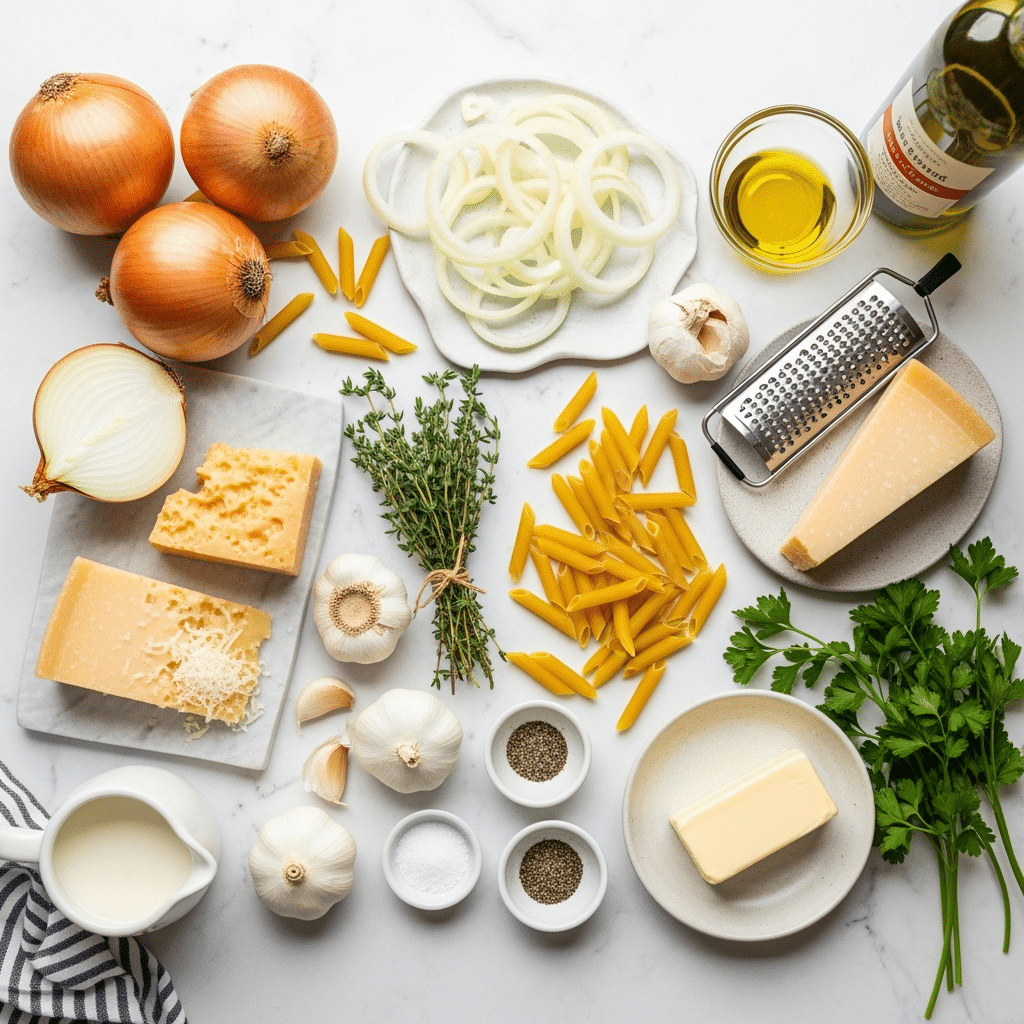
Quality ingredients are key to exceptional One-Pan French Onion Pasta. Each component creates rich, savory flavors in this pasta recipe. I’ve perfected my choices to ensure every bite is delicious.
The right mix of pasta, onions, broth, and cheese elevates a simple meal. Let’s explore how to select each ingredient for restaurant-quality results at home.
Pasta Choices
Pasta shape affects how well sauce clings to each piece. I suggest orecchiette, linguine, or short-cut pasta for best results. These shapes grab caramelized onion flavors beautifully.
Orecchiette’s cup-like shape holds onions and cheese perfectly. Linguine pairs wonderfully with French onion flavors. Short-cut pasta like penne offers convenience while still delivering excellent sauce adherence.
Onions and Their Types
Yellow onions are my top choice for perfect caramelization. They have the ideal balance of sugars and sulfur compounds. This creates deep, golden-brown flavors we love in French onion soup.
Sweet onions may caramelize too quickly and lack complexity. White onions are too sharp and don’t develop rich sweetness. Stick with yellow onions for consistently delicious results.
Broth or Stock Options
Your broth choice greatly influences the final flavor profile. Beef bouillon creates the most authentic French onion taste. It provides a deep, savory foundation that complements caramelized onions perfectly.
Vegetable broth offers a lighter alternative that’s still flavorful. Homemade stock elevates the dish to gourmet levels. I keep quality bouillon cubes handy for convenience without sacrificing taste.
Cheese Varieties
Gruyere remains my favorite choice for its melting properties and nutty flavor. Parmesan adds a sharp, salty contrast that enhances the overall taste experience.
For dietary restrictions, dairy-free alternatives like Panacheeza work surprisingly well. These options melt smoothly and provide satisfying richness. Always grate your cheese fresh for best melting and flavor.
Step-by-Step Cooking Instructions
This method turns basic ingredients into an amazing easy pasta dinner. It uses precise timing and technique. The process builds flavors slowly and knows when each part is just right.
The recipe follows a specific order for best flavor. We start with caramelized onions as the base. Then, we cook pasta in flavorful liquid. Lastly, we add cheese for a creamy finish.
Preparing the Onions
Heat butter and olive oil in a large skillet. Add thinly sliced yellow onions when the fat shimmers. Stir the onions every 5-7 minutes for 25-35 minutes.
The onions need patience and attention. They’re ready when deep amber and sweet-smelling. Add minced garlic, fresh thyme, and white wine to deglaze.
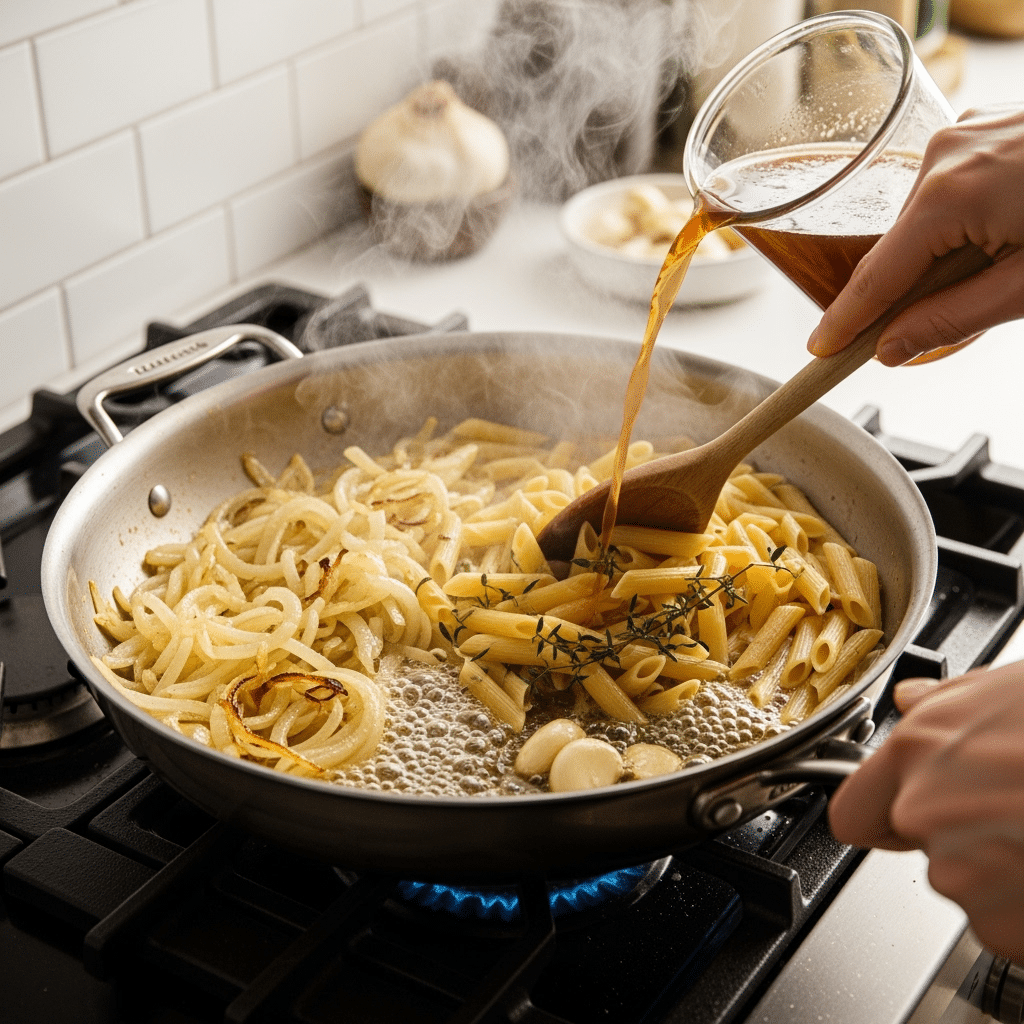
Cooking the Pasta Together
Add beef broth to the onions and bring to a boil. Add egg noodles or penne pasta. Stir often to prevent sticking.
The liquid should just cover the noodles. Add more broth if needed. Cook until pasta is al dente, about 2-3 minutes less than package directions.
Finalizing with Cheese
Remove from heat and stir in heavy cream. Add Gruyère and Parmesan cheese gradually, stirring constantly. This creates a smooth, luxurious sauce.
Season with salt and pepper. Sprinkle with fresh parsley. Serve this easy pasta dinner right away for the best creamy texture.
Tips for Perfecting My One-Pan Pasta
Essential cooking techniques can transform average one-pan pasta into an outstanding dish. These methods help achieve restaurant-quality results in your kitchen. Each tip addresses common challenges when making this skillet pasta recipe.
Getting Golden Onion Perfection
Proper onion caramelization is crucial for this dish. Slice onions uniformly, about ¼-inch thick, for even cooking. Patience is your best friend here – rushing ruins the flavor profile.
Cook onions over medium-low heat for 15-20 minutes, stirring occasionally. They should turn deep golden brown, not burnt black. Lower the heat if dark spots form.
Add a pinch of salt early to draw out moisture. This speeds up caramelization naturally. Onions are ready when soft, sweet, and beautifully golden.
Timing Your Cook Perfectly
Different pasta shapes need different cooking times. Check package directions and subtract 2 minutes from the recommended time. The pasta continues cooking in hot broth after removal from heat.
Stir pasta every 2-3 minutes to prevent sticking. Add hot broth in ¼-cup increments if liquid evaporates too quickly. Never add cold liquid – it affects cooking consistency.
Test pasta doneness by tasting, not timing. It should have a slight bite but no hard center. It will soften slightly more as it rests.
Creative Ingredient Additions
This recipe welcomes many variations. Add mushrooms during onion caramelization for incredible flavor depth. Sauté them for 5-7 minutes before adding pasta.
Cook protein separately and add during the final 2 minutes. This prevents overcooking while ensuring proper heating. Find similar techniques in this garlic butter chicken skillet recipe.
Fresh herbs like thyme or rosemary work well when added with broth. Frozen vegetables need only 3-4 minutes of cooking time.
| Addition Type | When to Add | Cooking Time | Best Options |
|---|---|---|---|
| Fresh Vegetables | With onions | 8-12 minutes | Bell peppers, zucchini, carrots |
| Proteins | Cook separately first | 2 minutes to heat | Chicken, beef, sausage |
| Frozen Vegetables | Last 3-4 minutes | 3-4 minutes | Peas, corn, spinach |
| Fresh Herbs | With broth | Full cooking time | Thyme, rosemary, sage |
Understanding cooking times is key to successful customization. Add ingredients based on their proper cooking duration. This approach ensures every component reaches perfect doneness simultaneously. Learn more about traditional one-pot pasta methods for additional tips.
Common Mistakes to Avoid
Three key areas often trip up home cooks when making caramelized onion pasta. These errors can turn a potentially amazing dish into a disappointment. Let’s explore these common mistakes and how to sidestep them.
Overcooking the Pasta
Many cooks forget that pasta keeps cooking after it’s removed from heat. This oversight leads to mushy noodles in the final dish.
To prevent this, cook pasta one minute less than the package suggests. Test it frequently during the last few minutes of cooking. The pasta should have a slight bite when you take it off the heat.
Remember, you can’t fix overcooked pasta. But slightly undercooked pasta will reach perfection in the hot pan with other ingredients.
Skipping the Caramelization Process
Rushing onion caramelization ruins the flavor of caramelized onion pasta. True caramelization requires at least 15 minutes of patient cooking.
High heat creates burnt, bitter onions instead of sweet, golden ones. Use low, slow heat to develop the onions’ natural sugars properly.
Watch for the color change from white to golden brown. If onions brown too fast, lower the heat and add broth to prevent burning.
Using Wrong Cheese Types
Cheese selection can make or break this dish. Pre-shredded cheese contains additives that prevent smooth melting, creating a grainy texture.
Always use freshly grated cheese for the best results. Gruyere, Parmesan, and Swiss cheese work beautifully in caramelized onion pasta.
Add cheese off the heat to prevent it from seizing up. Let residual heat melt it gradually for a silky, restaurant-quality finish.
| Common Mistake | Why It Happens | Correct Technique | Result |
|---|---|---|---|
| Overcooked Pasta | Following package directions exactly | Cook 1 minute less than directed | Perfect al dente texture |
| Rushed Onions | Using high heat to save time | Low heat for 15+ minutes | Sweet, golden caramelization |
| Pre-shredded Cheese | Convenience over quality | Freshly grated cheese | Smooth, creamy melting |
| Adding Cheese Too Hot | Impatience with temperature | Remove from heat first | Silky, non-grainy texture |
Serving Suggestions
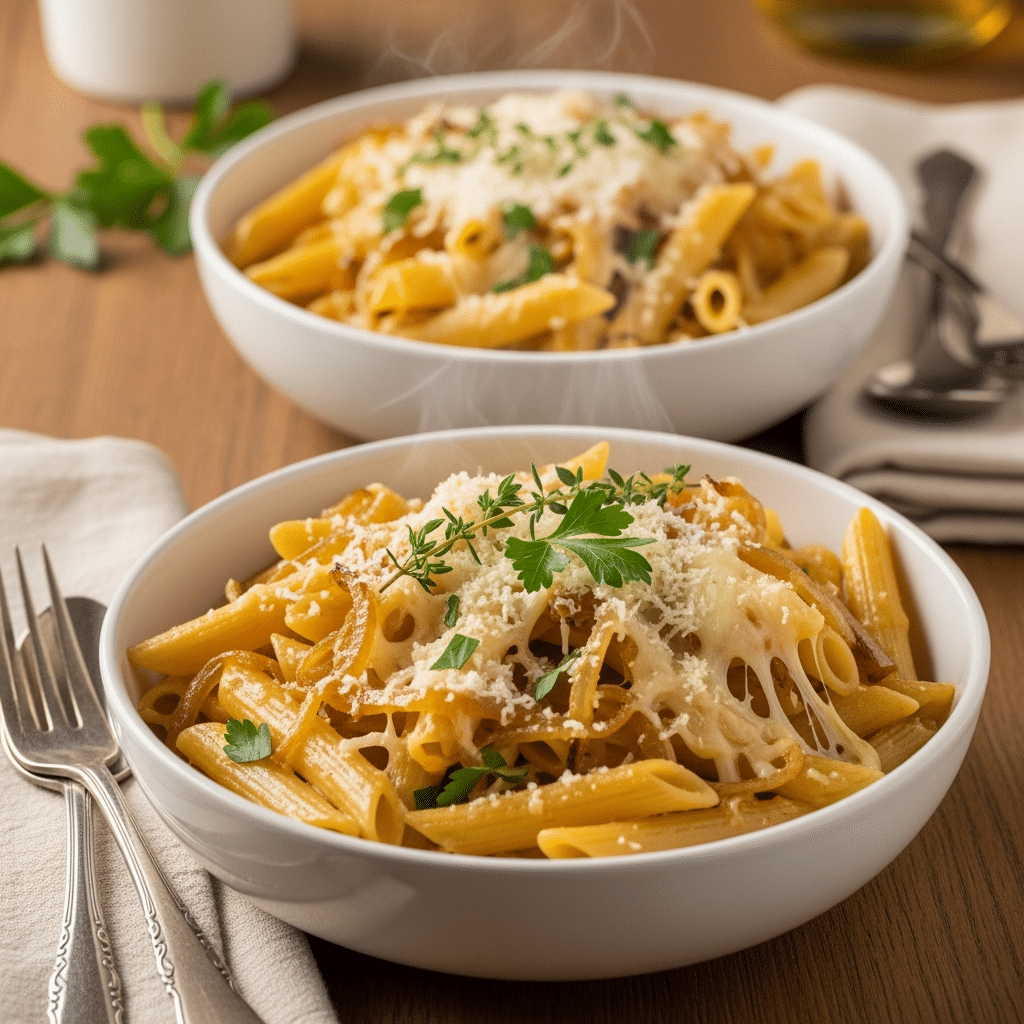
One-Pan French Onion Pasta pairs well with various sides. This rich, savory dish suits both casual family meals and guest entertaining. The right accompaniments can elevate this comfort food into a complete dining experience.
Fresh Salad Combinations
A crisp, refreshing salad balances the rich onion flavors. Arugula salad with lemon vinaigrette cuts through the cheese nicely. Its peppery bite complements the sweet caramelized onions.
Mixed greens with cherry tomatoes and cucumber are great options too. A light balsamic dressing won’t overpower the pasta’s bold flavors. Baby spinach salads topped with toasted nuts add extra texture.
Perfect Side Accompaniments
Crusty bread is ideal for soaking up every bit of sauce. Warm, lightly buttered sourdough or French baguette works best. It ties in nicely with the French onion soup inspiration.
Roasted vegetables make excellent sides without overwhelming the pasta. Try simple roasted broccoli, asparagus, or Brussels sprouts. Garlic-roasted green beans are particularly tasty with this dish.
Wine lovers might enjoy a medium-bodied red like Côtes du Rhône or Pinot Noir. These enhance the caramelized onion flavors beautifully.
Main Course Presentation
This pasta serves 6-8 people generously as a main course. It’s suitable for casual weeknight dinner gatherings and formal dinner parties. Proper portioning and attractive presentation are key.
Serve family-style in a large, shallow bowl to showcase the golden pasta. Garnish with fresh thyme or chopped parsley for color. Individual pasta bowls work well for formal occasions.
This dish also works as a first course for lighter appetites. Its rich flavors satisfy even in smaller portions. It’s perfect for weeknight dinner parties with an elegant twist.
Storage and Reheating Tips
Proper handling techniques can transform leftovers into delicious meals. These methods help you enjoy one-pan French onion pasta for days. You’ll maintain rich flavors and avoid soggy, separated pasta.
Smart storage practices protect food safety and taste quality. Understanding how ingredients react to temperature and moisture is key.
Proper Storage Techniques
Cool pasta completely before refrigerating to prevent condensation. Airtight containers work best for freshness and odor prevention.
Properly stored pasta stays fresh for up to five days. Divide large batches into smaller portions for easier reheating.
Meal prep enthusiasts should prepare caramelized onions separately. Store them in a different container and combine with fresh pasta later.
| Storage Method | Container Type | Refrigerator Life | Best For |
|---|---|---|---|
| Complete Dish | Airtight Glass Container | 3-5 Days | Quick Reheating |
| Separated Components | Multiple Small Containers | 5-7 Days | Meal Prep |
| Individual Portions | Microwave-Safe Containers | 3-5 Days | Single Servings |
| Caramelized Onions Only | Small Sealed Jar | 7-10 Days | Recipe Components |
Best Ways to Reheat
The stovetop method is best for reheating this pasta. Add broth or milk to restore creaminess. Low heat prevents cheese separation and overcooking.
Microwave reheating works well for single portions. Cover with a damp paper towel and heat in 30-second intervals.
Adding fresh liquid during reheating is crucial. A tablespoon of broth or cream brings back the original texture.
Never reheat at high temperatures to avoid curdled cheese and rubbery pasta. Thaw frozen portions overnight in the refrigerator before reheating.
Nutritional Information
Let’s explore the nutritional facts of this meal. Understanding what you eat helps make smart choices about portions and dietary goals. This comfort food offers more than just great taste.
Breakdown of Key Nutrients
Each serving of one-pan French onion pasta contains about 515 calories. This is based on dividing the dish into eight portions. It’s a hearty main dish that satisfies hunger without excess.
| Nutrient | Amount per Serving | Daily Value % |
|---|---|---|
| Calories | 515 | 26% |
| Carbohydrates | 65g | 22% |
| Protein | 18g | 36% |
| Fat | 20g | 31% |
| Fiber | 4g | 16% |
The pasta provides complex carbs for lasting energy. Cheese adds protein and calcium for strong bones. Onions offer fiber, vitamins, and antioxidants to boost your immune system.
Most calories come from pasta and cheese. The broth adds flavor without extra fat. This balance makes it a good choice for regular meals.
Health Considerations
This recipe can fit different dietary needs. You can change it to meet health requirements while keeping it tasty.
For dairy-free diets, use nutritional yeast or dairy-free alternatives instead of cheese. This cuts calories while keeping the savory flavor you love.
Those eating gluten-free can use rice or chickpea pasta. These options often add extra protein and fiber to your meal.
Vegetarian versions work well with veggie broth instead of beef or chicken stock. You’ll get rich flavor from plant-based ingredients.
Watch portion sizes if you’re counting calories. The dish is filling, so try smaller servings with a salad. High fiber helps you feel full longer.
Sodium levels depend on your broth choice. Low-sodium broths cut salt while keeping flavor. Fresh herbs add taste without extra calories or sodium.
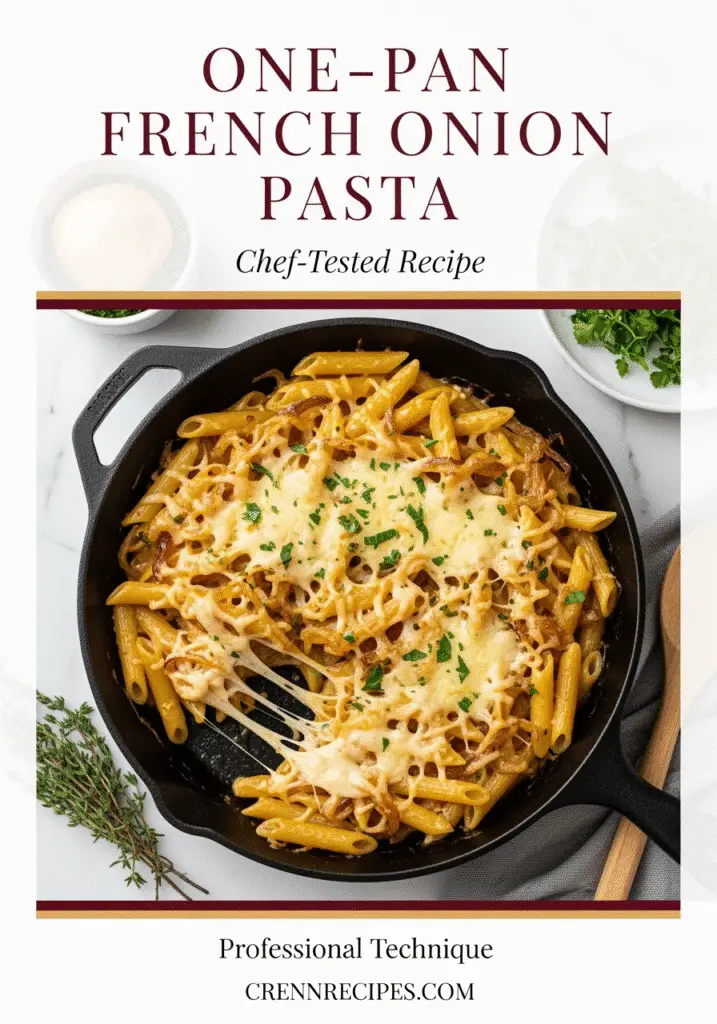
Final Thoughts on One-Pan French Onion Pasta
This one-pan French onion pasta is a game-changer for comfort food lovers. It turns simple ingredients into a culinary masterpiece. The dish never fails to impress with its rich flavors and easy preparation.
Why This Recipe Wins Every Time
The caramelized onions create a savory base that makes every bite satisfying. Cooking everything in one pan means less cleanup and more enjoyment. This dish delivers maximum flavor with minimal effort.
Perfect for Any Occasion
This pasta is ideal for quick weeknight dinners. It’s also a hit at dinner parties, with guests always asking for the recipe. The dish provides warmth and coziness during colder months.
It’s easy to scale up for larger gatherings. The versatility makes it suitable for various occasions.
Make It Your Own
Feel free to experiment with different cheese combinations or add fresh herbs. Try including vegetables like mushrooms or spinach for extra flavor. Some have added bacon or used different pasta shapes with great results.
The recipe’s flexibility allows for endless variations. You can easily adapt it to suit your taste preferences.
Try this one-pan French onion pasta in your kitchen. It’s likely to become a regular in your meal rotation.
FAQ
How long does it take to make One-Pan French Onion Pasta?
This recipe takes about 20 minutes to make. Caramelizing onions takes 8-10 minutes. Cooking pasta in the broth takes another 10-12 minutes.
What type of pasta works best for this french onion recipe?
Short pasta shapes like penne, rigatoni, or shells work best. Their ridges and curves capture the rich, cheesy sauce well. Avoid delicate pasta like angel hair.
Can I use any type of onions for this skillet pasta?
Yellow onions are ideal for this recipe. They caramelize well and develop deep, sweet flavors. Sweet onions like Vidalia are also great choices.
Red onions can be too sharp. White onions don’t develop the same rich flavor profile.
What’s the secret to perfectly caramelized onions?
Patience is key! Cook onions over medium heat for 8-10 minutes, stirring occasionally. They should turn golden brown and smell sweet.
Don’t rush by increasing the heat. This can burn the onions instead of caramelizing them properly.
Can I substitute the cheese in this recipe?
Yes! While Gruyere is traditional, you can use Swiss, mozzarella, or sharp cheddar. For a lighter version, try reduced-fat cheese or nutritional yeast.
The key is using a cheese that melts well and complements the caramelized onions.
How do I prevent the pasta from becoming mushy?
Cook the pasta just until al dente. This is usually 1-2 minutes less than the package directions suggest.
The pasta continues cooking in the hot liquid even after removing it from heat.
Can I make this recipe ahead of time?
You can prepare the caramelized onions ahead and store them in the fridge for up to 3 days. When ready, reheat the onions and continue with the pasta cooking process.
What should I serve alongside this pasta?
A simple green salad with vinaigrette pairs well. Crusty French bread or garlic bread also complements the dish nicely.
For a complete meal, add grilled chicken or serve it as a hearty vegetarian main course.
How do I store and reheat leftovers?
Store leftovers in the fridge for up to 3 days in an airtight container. To reheat, add broth or milk to restore creaminess.
Heat gently on the stovetop over low heat, stirring often. Or microwave in 30-second intervals, stirring between each.
Is this recipe suitable for meal prep?
Yes! This one-pot meal works well for meal prep. Divide into containers and refrigerate for up to 4 days.
The flavors improve overnight, making it an excellent make-ahead option for busy weeks.
Can I add vegetables or protein to this recipe?
Definitely! Mushrooms, spinach, or roasted bell peppers work well. For protein, try chicken, Italian sausage, or leftover roast beef.
Add veggies during onion caramelization. Add cooked proteins in the final few minutes to warm through.
What if I don’t have beef broth?
Vegetable or chicken broth work as excellent substitutes. Each gives a slightly different flavor profile. You can even use a mix of broth and white wine for extra depth.
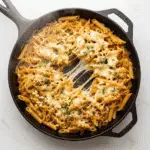
One-Pan French Onion Pasta: 20-Minute Comfort Food Recipe
- Total Time: 55 minutes
- Yield: 8 servings 1x
- Diet: Vegetarian
Description
This one-pan French onion pasta combines the rich, caramelized flavors of classic French onion soup with tender pasta in a single skillet. Perfect for busy weeknights, this restaurant-quality dish takes just 20 minutes and creates minimal cleanup while delivering maximum comfort food satisfaction.
Ingredients
4 large yellow onions, thinly sliced
12 oz penne or rigatoni pasta
2 tablespoons butter
2 tablespoons olive oil
3 cloves garlic, minced
1/2 cup white wine
4 cups beef broth
1/2 cup heavy cream
1 cup gruyere cheese, grated
1/2 cup parmesan cheese, grated
2 teaspoons fresh thyme
Salt and pepper to taste
Fresh parsley for garnish
Instructions
1. Heat butter and olive oil in large skillet over medium heat
2. Add sliced onions and cook 25-35 minutes, stirring every 5-7 minutes until deep golden brown
3. Add garlic and thyme, cook 1 minute until fragrant
4. Pour in white wine to deglaze, scraping up browned bits
5. Add beef broth and bring to a boil
6. Add pasta and stir frequently, cooking until al dente (2-3 minutes less than package directions)
7. Remove from heat and stir in heavy cream
8. Gradually add gruyere and parmesan cheese, stirring until melted
9. Season with salt and pepper to taste
10. Garnish with fresh parsley and serve immediately
Notes
For best results, slice onions uniformly for even caramelization
Don’t rush the onion cooking process – patience creates the best flavor
Use freshly grated cheese for smoothest melting
Add cheese off heat to prevent seizing
Leftovers keep 3-5 days refrigerated
- Prep Time: 10 minutes
- Cook Time: 45 minutes
- Category: Main Course
- Method: One-Pan
- Cuisine: French-American
Nutrition
- Serving Size: 1 cup
- Calories: 515
- Sugar: 8g
- Sodium: 680mg
- Fat: 20g
- Saturated Fat: 12g
- Unsaturated Fat: 6g
- Trans Fat: 0g
- Carbohydrates: 65g
- Fiber: 4g
- Protein: 18g
- Cholesterol: 55mg

